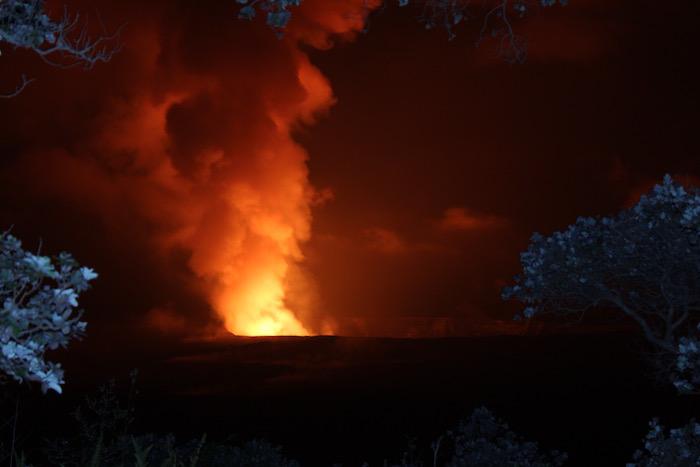
After the explosion, the crater's lava pool lit up the night/NPS
Editor's note: The following dispatch was written by Hawai'i Volcanoes National Park's Jessica Ferracane.
An explosion from Kīlauea volcano’s summit Saturday evening flung chunks of molten and solid rock onto the rim of Halema‘uma‘u Crater, turned night into day, and destroyed the power system for scientific equipment used to monitor the volcano.
The explosion, which occurred just past 10 p.m. on August 6, further justifies the closure by the National Park Service of the summit lava lake and Halema‘uma‘u Overlook, and the partial closure of about four miles of the 11-mile Crater Rim Drive and Crater Rim Trail. The closures have been in place since 2008 when the current summit eruption began.
“This type of volcanic explosion is not that uncommon at the summit of Kīlauea, and could have easily killed or seriously injured and burned anyone in the area,” said Park Superintendent Cindy Orlando. “Despite the closure, people continue to trespass into the closed area, putting themselves and first responders at great risk,” she said.
Park ranger Tim Hopp was on routine patrol of the closed Halema‘uma‘u Overlook parking lot in his vehicle Saturday night. Suddenly, the dark sky lit up bright orange, “so surreal and bright you could read a book,” he said.
He heard a violent and extremely loud sloshing sound from the crater. Fragments of volcanic rock, or tephra, were ejected from the volcano and rained down on his patrol vehicle as he cautiously left the area, respirator on. He noticed the USGS Hawaiian Volcano Observatory equipment perched on the rim shooting off light as electrical wires burned. “It lasted about a half hour,” Hopp said.
An hour later, Hopp cited two individuals for sneaking into the closed area to get a closer look at the potentially lethal lava lake.
According to USGS Hawaiian Volcano Observatory, rocks in the vent wall can become unstable and crash into the lava lake when the level drops, which has been the pattern the last few days. The explosion covered the southeast crater rim with a layer of tephra about 8 inches thick in places, and lava bombs and spatter were hurled nearly 300 feet out beyond the crater rim at the closed overlook, extending over an area about 720 feet in width along the rim.
“Part of the mission of the national park is to provide safe access to active volcanism, and our emphasis is always on safety,” Superintendent Orlando said. “The view of the summit eruption is fantastic one mile away from the Jaggar Museum observation deck, and that’s as close as visitors can safely get,” she said.
The park has no plans to reopen the closed areas until the eruption from Halema‘uma‘u ceases, she added.



Add comment